
Invoice processing involves multiple steps, including approval processes, payments, dunning (sending reminders on open invoices), and credit note invoices (notes that signify changes made to invoice values). Improve the invoice processing process with automation This can ultimately foster customer loyalty and punctual payments. How you issue invoices is also important.įor example, sending consolidated invoices can help you make life easier for the accounting department of your customers. Monitoring your invoices is a large part of your (or your accounting department’s) accounts receivable work.Ī badly organized invoicing process will negatively affect your cash flow and leave you prone to missing outstanding invoices. Invoices not only detail purchases and make transactions run smoothly but also provide details used to pay taxes or settle commercial disputes. In modern English, an invoice is technically a ‘ sales invoice‘ to the seller and a ‘ buyer’s invoice‘ to the buyer. ‘ Invoy’, which came from the French word ‘ envoyer’, which was used to mean ‘ to send’. The word ‘invoice’ itself originally comes from the mid-sixteenth century. It also stipulates when and where the payment is due. It is sent by the seller/service/provider to the buyer/service user and lists both parties’ information. What are invoices?Īt its most basic level, an invoice (sometimes known as a bill or tab) is a document detailing the costs and payment terms of services or products sold. We will discuss some of these further below.īut first, let’s look a bit closer at invoices. Payment of invoices can remain open for a number of reasons, some good and some bad.

Open Invoice DefinitionĪn open invoice (also known as an outstanding invoice) is simply an invoice that has been issued by the seller/vendor but not yet paid (or paid fully) by the buyer/client.Īn invoice is considered a closed invoice once it has been fully processed and paid. Let us explain the points of difference and how you might influence them.

There are many factors that influence the status of invoices. ‘ Open invoices‘ and ‘ closed invoices‘ invoices are terms often used in business and accounting.īut what are they exactly? Why are they important? And what types of open invoices are there?


 0 kommentar(er)
0 kommentar(er)
